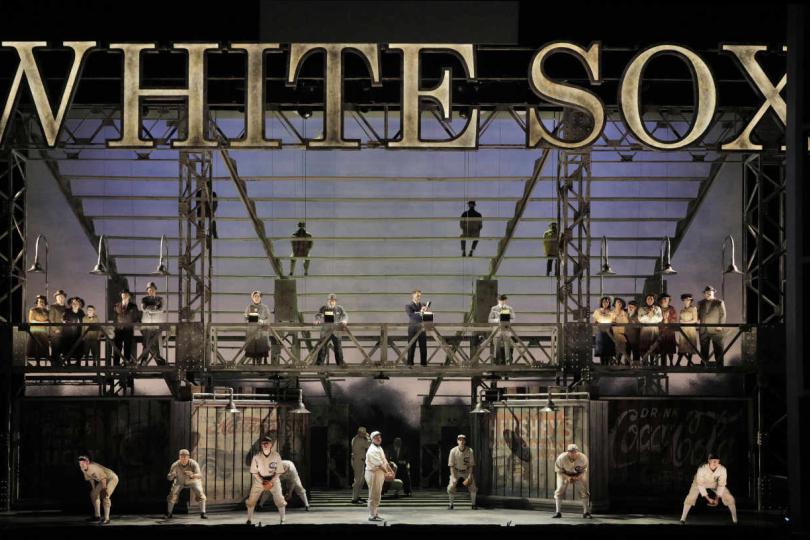Swinging for the fences

In my earliest memory of baseball I’m probably four years old. At dusk on a summertime farm in Iowa I remember listening to Cubs games on the AM radio. My dad listened so I did too. Listening to the games seemed important to him, it was some kind of ritual I didn’t fully understand. These nine random men playing a game in another state somehow represented us. We were somehow connected and their victories were our victories. It was important that they were upstanding role models and that I gave them my unflinching support. In his documentary series, documentarian Ken Burns said "What encodes and stores the genetic material of our civilization - passing down to the next generation the best of us, what we hope will mutate into betterness for our children and our posterity? Baseball provides one answer."
Though a bit unlikely, I think baseball is the perfect subject matter for an opera. Baseball is a simple thing but has come to represent the incredibly complex thing of American identity. To discuss baseball is to discuss American values, character, history, successes, and failures. With their newly developed work “The Fix”, MN Opera tells the tale of a dark chapter in our American identity. In one of the greatest scandals in all of sports, the 1919 Chicago Black White Sox intentionally lost the world series to profit from betting against themselves. THIS STORY HAS EVERYTHING! Good guys, bad guys, good guys who become bad guys, scandal, fame, fortune, regret, heartache, comeuppance, it’s all there! Further, this is a historic event that I only lightly know. It’s the perfect plot for an opera, and it’s timed perfectly to premiere on the year of the 100th anniversary of the events. The perfection of its design makes me all the more saddened to tell you that (in my opinion) the writing of this opera doesn’t live up to its potential.
Per usual, MN Opera did a lot of things perfectly in this production. Visually, the stage was stunning. The backdrop of the ‘underbelly’ of a baseball stadium (circa 1919) was captivating. The period-stylized logos and materials were both nostalgic and seemingly contemporary. The “WHITE SOX” sign was illuminated with an other-worldly glow that transformed perfectly to the team’s less flattering moniker. The MN Opera orchestra played with perfection. Those musicians brought this new score to life with unimpeachable mastery. The cast performed with passion and commitment, both vocally and visually. However, the pacing of the story and the characters developed in this script aren’t innately captivating. I don’t offer these critiques lightly so I’ll be specific.
Pacing-wise, the action on the stage seems to defy the expectation of an audience for any sort of sports story. The clear focal point of a sports story is the game itself but in this opera, the athletic high point happens at the end of act 1 with act 2 having no real main event. This tale is also a ‘heist’ story in a way: A group of nefarious gamblers seeks to corrupt the idealistic ball players and they all end up digging a deeper and deeper hole. “The Fix” has moments where the heist feels urgent but it never really pays off. At various times it’s also; a courtroom drama (but doesn’t culminate in any Atticus Finch-esque monologues), a morality play (but the protagonist never takes a firm stance), a romance (but a reticent one), and a mob story (but we never get too much information about the vaguely Mafioso bad guys).
Character-wise, the Shoeless Joe Jackson of this opera doesn’t deserve to be our protagonist. In the how-to screenwriting book Save the Cat!, author and screenwriter Blake Snyder talks about a protagonist by saying: “...liking the person we go on a journey with is the single most important element in drawing us into the story.” In this opera, I just didn’t like Shoeless Joe. His character is presented as an all-American good old boy who’s supposedly wholesome through and through but he never actually demonstrates any of those qualities. Throughout the opera he’s a passive character who never makes bold choices and never even quite knows what he wants. Save the Cat! describes what it takes for an audience to accept a protagonist as being worthy of their admiration by saying: “It’s the scene where we meet the hero and the hero does something - like saving a cat - that defines who he is and makes us, the audience, like him.” While I never accepted Shoeless Joe as the protagonist, I wanted to see a lot more of some of the ‘bad guys’. The character of Chick is tremendous! As the ringleader of the team’s seedy behavior he’s supposedly the villain but he was absolutely the most fascinating character on the stage. Though his nickname is less snappy, I feel that Chick should have taken over for Shoeless Joe as the protagonist of this story.
Balance-wise, this show only has 1 female character. There are female ‘flapper’ dancers and a couple girls in bars but this show definitely doesn’t pass the Bechdel test. Yes, the actual players of 1919 were all male but that doesn’t mean the story is entirely masculine. In my opinion, the show felt consistently out of balance being filled with almost exclusively macho male characters.
At the risk of overstepping my area of expertise, I will now offer a theory as to why I feel there are so many writing problems with this show. In any movie or television show there is a team of writers that brings the idea to life. A good team obviously acts as a focus group, balancing out each individual’s ideas to create a well-rounded product that feels successful to the entire team. The entire script (‘libretto’ in opera-speak), plot, character-development, and stage direction for “The Fix” was done by 1 person. I don’t know Eric Simonson, from afar he seems like an intelligent and ambitious man. I believe this opera should have employed a writing team to create a more well-rounded product; any single person can’t be expected to see the show from a variety of perspectives, only their own. While it’s true that most operas have a single librettist, most are based on existing movies or plays or books so in effect the librettist is part of a team, if only separated by time and space. From what I understand of this new work, Eric Simonson did the research, chose the characters, developed them into personalities for the stage, crafted the arc of the story, the pacing, and a thousand other things that would have had entire teams working on them for any other media. I feel that Mr. Simonson achieved a Herculean feat by bringing this piece to life but that crafting a well-rounded piece of this size is too big of a job for any single writer.
I’m glad this opera exists. I’m thrilled that I get to live in a place where ambitious people make ambitious things and ambitious audiences show up. At its best, opera (and MN Opera specifically) is the most thrilling and captivating experience imaginable. I want to uphold that standard and hope for it every time. The initial run of this new work only lasts through this weekend. Get there if you can.




